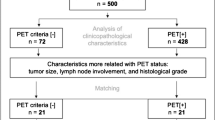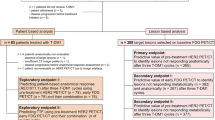Abstract
Purpose
To evaluate whether tumor uptake of [89Zr]trastuzumab can distinguish HER2-positive from HER2-negative breast cancer.
Methods
Women with HER2-positive (n = 34) and HER2-negative (n = 16) breast cancer underwent PET/CT 5 ± 2 days following [89Zr]trastuzumab administration. HER2 status was determined based on immunohistochemistry and/or fluorescence in situ hybridization of primary or metastatic/recurrent tumor. Tumor [89Zr]trastuzumab uptake was assessed qualitatively and semiquantitatively as maximum standardized uptake value (SUVmax), and correlated with HER2 status. Additionally, intrapatient heterogeneity of [89Zr]trastuzumab uptake was evaluated.
Results
On a per-patient basis, [89Zr]trastuzumab-PET/CT was positive in 30/34 (88.2%) HER2-positive and negative in 15/16 (93.7%) HER2-negative patients. Considering all lesions, the SUVmax was not significantly different in patients with HER2-positive versus HER2-negative disease (p = 0.06). The same was true of when only hepatic lesions were evaluated (p = 0.42). However, after excluding hepatic lesions, tumor SUVmax was significantly higher in HER2-positive compared to HER2-negative patients (p = 0.003). A cutoff SUVmax of 3.2, determined by ROC analysis, demonstrated positive-predictive value of 83.3% (95% CI 65.3%, 94.4%), sensitivity of 75.8% (57.7%, 88.9%), negative-predictive value of 50% (24.7%, 75.3%), and specificity of 61.5% (95% 31.6%, 86.1%) for differentiating HER2-positive from HER2-negative lesions. There was intrapatient heterogeneity of [89Zr]trastuzumab uptake in 20% of patients with multiple lesions.
Conclusions
[89Zr]trastuzumab has the potential to characterize the HER2 status of the complete tumor burden in patients with breast cancer, thus obviating repeat or multiple tissue sampling to assess intrapatient heterogeneity of HER2 status.



Similar content being viewed by others
References
Siegel RL, Miller KD, Jemal A (2017) Cancer statistics, 2017. CA Cancer J Clin 67(1):7–30
Wolff AC, Hammond ME, Hicks DG et al (2013) Recommendations for human epidermal growth factor receptor 2 testing in breast cancer: American Society of Clinical Oncology/College of American Pathologists clinical practice guideline update. J Clin Oncol 31(31):3997–4013
Lv Q, Meng Z, Yu Y et al (2016) Molecular mechanisms and translational therapies for human epidermal receptor 2 positive breast cancer. Int J Mol Sci 17(12):2095
Niikura N, Liu J, Hayashi N et al (2012) Loss of human epidermal growth factor receptor 2 (HER2) expression in metastatic sites of HER2-overexpressing primary breast tumors. J Clin Oncol 30(6):593–599
Niikura N, Tomotaki A, Miyata H et al (2016) Changes in tumor expression of HER2 and hormone receptors status after neoadjuvant chemotherapy in 21,755 patients from the Japanese breast cancer registry. Ann Oncol 27(3):480–487
Laforest R, Lapi SE, Oyama R et al (2016) [Zr]trastuzumab: evaluation of radiation dosimetry, safety, and optimal imaging parameters in women with HER2-positive breast cancer. Mol Imaging Biol 18(6):952–959
Dijkers EC, Oude Munnink TH, Kosterink JG et al (2010) Biodistribution of 89Zr-trastuzumab and PET imaging of HER2-positive lesions in patients with metastatic breast cancer. Clin Pharmacol Ther 87(5):586–592
Vosjan MJ, Perk LR, Visser GW et al (2010) Conjugation and radiolabeling of monoclonal antibodies with zirconium-89 for PET imaging using the bifunctional chelate p-isothiocyanatobenzyl-desferrioxamine. Nat Protoc 5(4):739–743
Lindmo T, Boven E, Cuttitta F, Fedorko J, Bunn PA Jr (1984) Determination of the immunoreactive fraction of radiolabeled monoclonal antibodies by linear extrapolation to binding at infinite antigen excess. J Immunol Methods 72(1):77–89
Laforest R, Lapi SE, Oyama R et al (2016) [89Zr]trastuzumab: evaluation of radiation dosimetry, safety, and optimal imaging parameters in women with HER2-positive breast cancer. Mol Imaging Biol 18(6):952–959
Lindstrom LS, Karlsson E, Wilking UM et al (2012) Clinically used breast cancer markers such as estrogen receptor, progesterone receptor, and human epidermal growth factor receptor 2 are unstable throughout tumor progression. J Clin Oncol 30(21):2601–2608
Rossi S, Basso M, Strippoli A et al (2015) Hormone receptor status and HER2 expression in primary breast cancer compared with synchronous axillary metastases or recurrent metastatic disease. Clin Breast Cancer. 15(5):307–312
Ieni A, Barresi V, Caltabiano R et al (2014) Discordance rate of HER2 status in primary breast carcinomas versus synchronous axillary lymph node metastases: a multicenter retrospective investigation. Onco Targets Ther 7:1267–1272
Mortimer JE, Bading JR, Park JM et al (2017) Tumor uptake of 64Cu-DOTA-trastuzumab in patients with metastatic breast cancer. J Nucl Med. https://doi.org/10.2967/jnumed.117.193888
Gebhart G, Lamberts LE, Wimana Z et al (2016) Molecular imaging as a tool to investigate heterogeneity of advanced HER2-positive breast cancer and to predict patient outcome under trastuzumab emtansine (T-DM1): the ZEPHIR trial. Ann Oncol 27(4):619–624
Ulaner GA, Hyman DM, Ross DS et al (2016) Detection of HER2-positive metastases in patients with HER2-negative primary breast cancer using 89Zr-trastuzumab PET/CT. J Nucl Med 57(10):1523–1528
Van Poznak C, Somerfield MR, Bast RC et al (2015) Use of biomarkers to guide decisions on systemic therapy for women with metastatic breast cancer: American Society of Clinical Oncology Clinical Practice Guideline. J Clin Oncol 33(24):2695–2704
Acknowledgements
This work was supported by National Cancer Institute Grant CA182945, U.S. Department of Energy Grant DE-SC0012737, and the Alvin J. Siteman Cancer Center Imaging and Response Assessment Core.
Author information
Authors and Affiliations
Corresponding author
Ethics declarations
Conflict of interest
The authors declare that they have no conflict of interest.
Ethical approval
All procedures performed in studies involving human participants were in accordance with the ethical standards of the institutional and/or national research committee and with the 1964 Helsinki declaration and its later amendments or comparable ethical standards.
Informed consent
Informed consent was obtained from all individual participants included in the study.
Rights and permissions
About this article
Cite this article
Dehdashti, F., Wu, N., Bose, R. et al. Evaluation of [89Zr]trastuzumab-PET/CT in differentiating HER2-positive from HER2-negative breast cancer. Breast Cancer Res Treat 169, 523–530 (2018). https://doi.org/10.1007/s10549-018-4696-z
Received:
Accepted:
Published:
Issue Date:
DOI: https://doi.org/10.1007/s10549-018-4696-z




